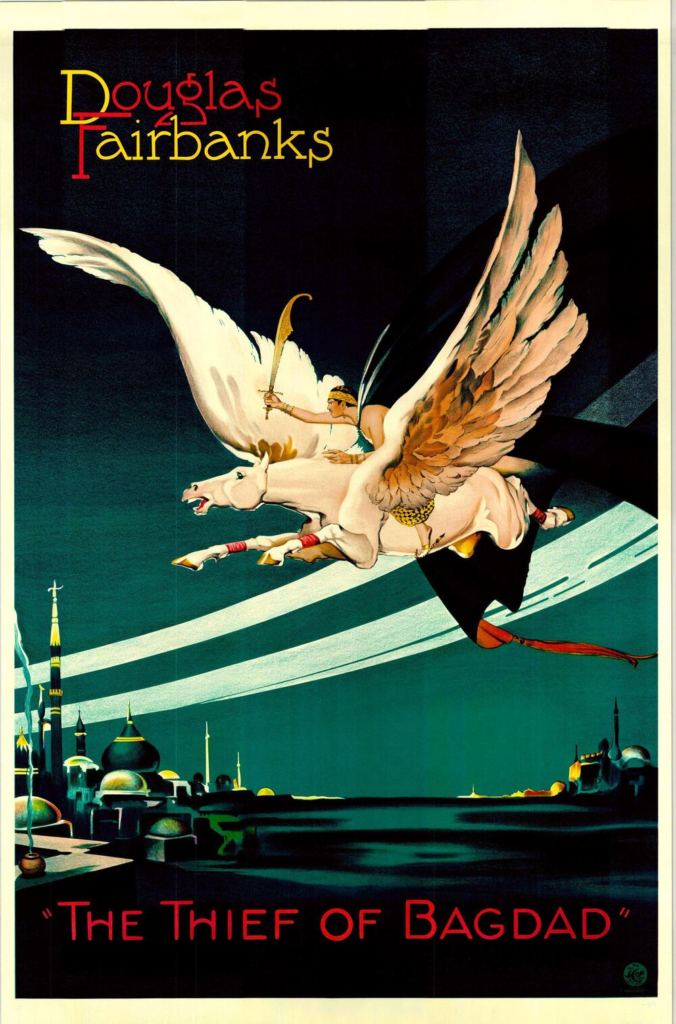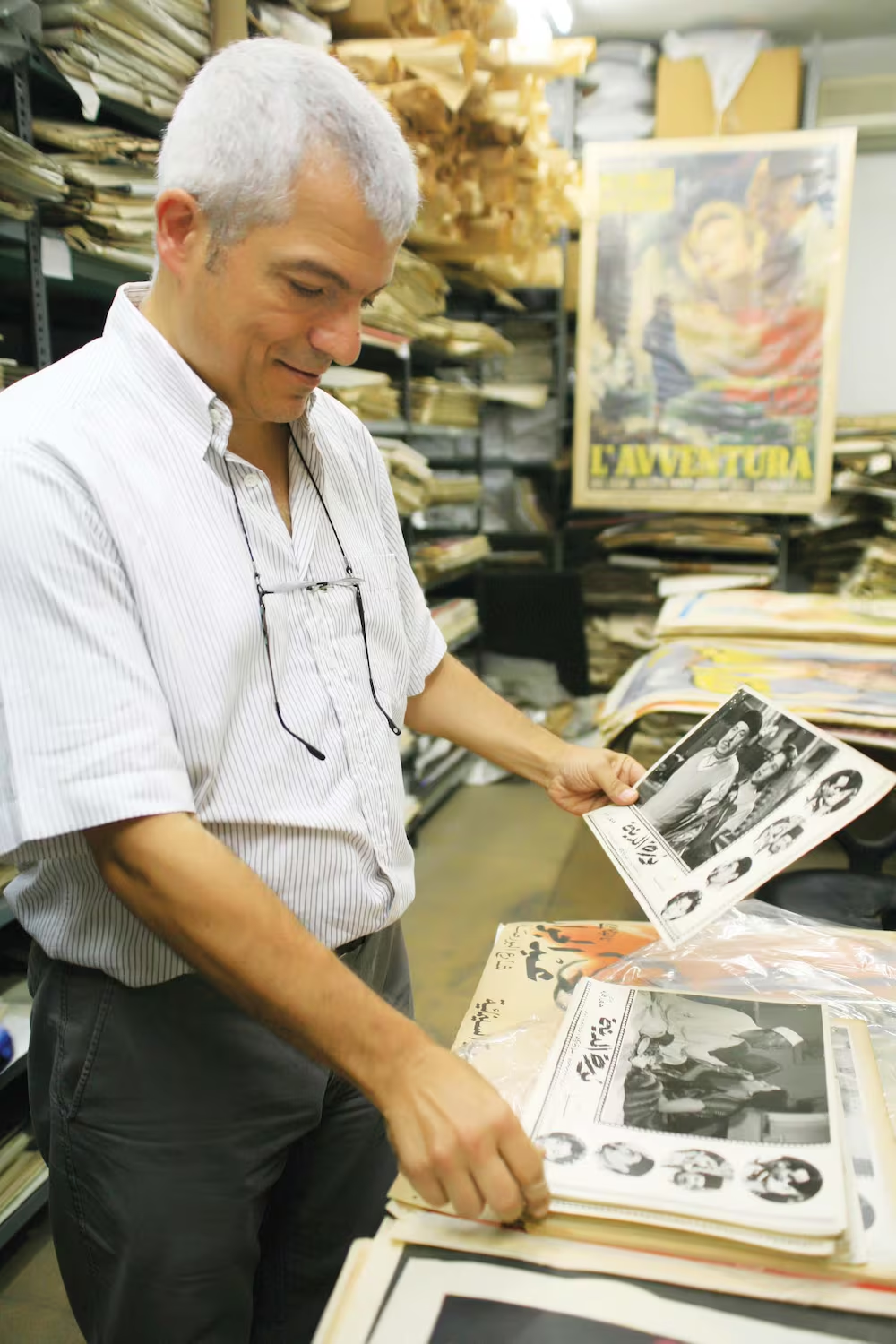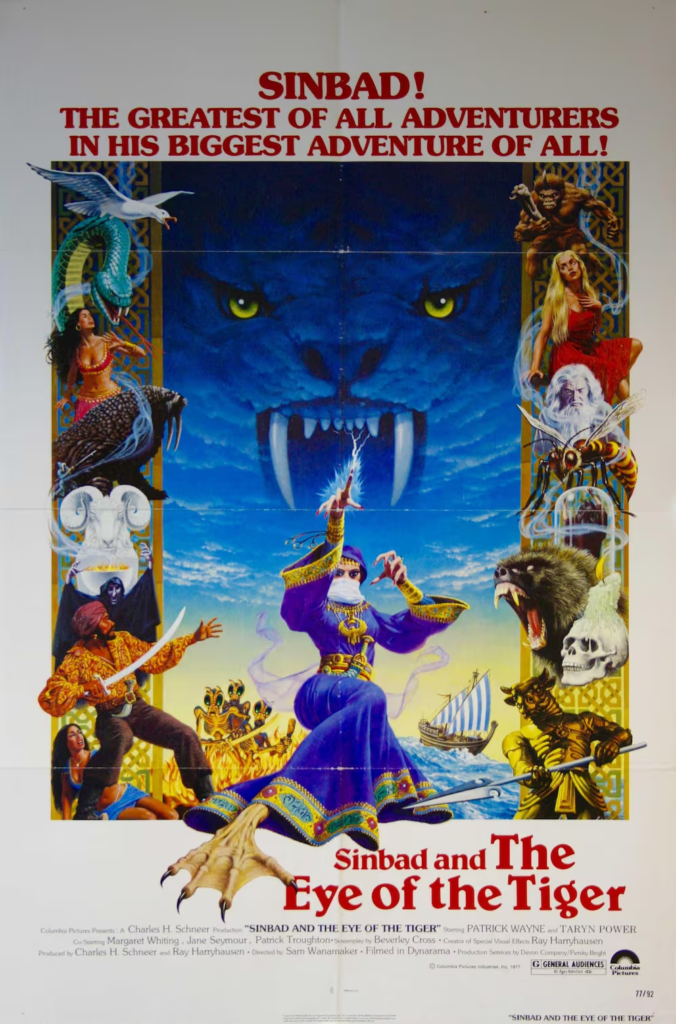A fascinating new exhibit in Beirut is showcasing 108 original movie posters advertising Western films set in the Arab world.

The original poster for the 1924 American film ‘Thief of Baghdad’. Courtesy Abboudi Abou Jaoude
The original poster for the 1924 American film Thief of Baghdad hangs on the wall of Dar El-Nimer for Arts and Culture in Beirut. Based on a story from One Thousand and One Nights, a collection of Middle Eastern folk tales, the film tells the story of a robber who pretends to be a prince after falling in love with a princess.
It features a young black-haired man flying through the night sky on a winged steed, above a city of domes and spires that looks more like Istanbul than the capital of Iraq. He clutches a gold scimitar with a wicked curved blade in one hand.
It is one of 10 posters, all advertising adaptations of the film in different languages. The silent swashbuckler was so popular that it was remade three times, in 1940, 1961 and 1978. The French poster for the 1940 version is particularly beautiful and lurid, featuring a procession of robed figures and elephants making their way through a marketplace in front of an orange palace. In the foreground, a boy in a large turban looks shiftily to one side as he bites into a piece of fruit, presumably stolen from a market stall. In the sky, another turbaned figure stands on a flying carpet.
The collection
The pieces are part of a selection of 108 original posters advertising western films set in the Arab world and are on loan from private collector Abboudi Abou Jaoude, the curator of the show. “I have about 550 posters and about 300 pictures in my collection,” he says, strolling through the exhibition, which is organised by genres designated by neon signs. He stops frequently to point out a detail that makes him laugh or to delve into the facets of a particular film. “I started collecting because my favourite actors were Steve McQueen and Clint Eastwood,” he says. “Bullitt was the first poster I collected. Then For a Few Dollars More, a Spaghetti Western from Eastwood. But afterwards my interest changed and I started collecting foreign posters.”

Collector Abboudi Abou Jaoude. Courtesy Abboudi Abou Jaoude and Dar el-Nimer
Jaoude chose to name the exhibition Thief of Bagdad, not only because the film was so popular, but because it inspired so many others. “Baghdad is the most popular city at the beginning of the movies. There are around 55 films made in the 20th century with Baghdad in the name,” he says.
Most of them were shot in studios in America or Europe and bear no resemblance to reality. Thanks to the Orientalist fascination with One Thousand and One Nights, the Baghdad of these films is a place of total fantasy, filled with camels and elephants, flying carpets and genies, as well as heroes, villains and damsels waiting to be rescued or wooed.
The posters are hand-drawn in riotous colours and often show several different scenes. Many feature white actors playing Arab characters and reinforce Orientalist tropes such as dashing desert sheikhs and feisty dancing girls, or enslaved beauties who await rescue by a civilised foreign hero.
Like the Orientalist painters of the 19th century, the filmmakers and poster artists are fascinated by the idea of the harem. Many of the posters feature statuesque, white women posing evocatively. Others are simply bizarre. A 1977 poster for Sinbad and the Eye of the Tiger features a woman in a niqab and a bejewelled purple and gold robe, who shoots lightning from her hand as she kicks towards the viewer with a giant foot that resembles an eagle’s talon.
‘It’s about imagination’
Jaoude has divided the exhibition into four sections: love, fantasy, adventure and comedy. A fifth section features the posters of films shot on location in the Middle East. Beirut and Cairo were particularly popular filming locations in the 1960s and early 1970s, he explains, because shooting costs were low. That they were shot in the Arab world didn’t make the films – or their posters – any more accurate or realistic, however. Many of them are espionage themed and feature gun-toting spies and Soviet villains in Lebanon, running around the ruins of Baalbeck or fighting on top of the crusader castle in Saida.
The artists had sometimes not even seen the films they were advertising, so they based the posters on their own ideas about the Middle East, explains Jaoude. “It’s about imagination. They take the story from Arabian Nights. You can see in the posters that it’s a continuation of Orientalism,” he says.
Because viewers would not have a chance to see trailers for the films, the posters were intended to excite audiences and convince them the film was worth their time and money. “The shapes that shook a Harem Empire!” is the excited legend on the poster for the 1952 British film Babes in Bagdad, positioned beside images of fair-skinned women in belly dancer costumes and chains. The poster promises: “All its spectacle captured in exotic colour.”
An Italian poster for the 1961 adaptation of Thief of Bagdad advertises “The fantastic deeds … the incredible daring of the thief who defied an empire!” At the bottom of the poster, the artist lists a series of features that viewers can expect in the film: “Adventure! Trees that become monsters! Adventure! Flying horses soar! Adventure! The faceless fighters! Adventure! Army created by magic! Adventure! Gigantic killer crab! Adventure! Men turned into stone!”
Jaoude has spent decades building up his collection, visiting cinemas in Morocco, Syria, Egypt and across the region. “Whenever I visit these countries, most days I go to the old cinemas, the ones around the city, not in the centre, because they leave these posters in the theatres for re-issues,” he says. “Every five or six years they show the films again because people like these kinds of movies. After 20 years we find it funny, but at the time we found it very nice. People like the hero, the way he fights with the villain. It was popular.”
The films featured in the exhibition, which date from the 1920s to the 1970s, were intended to make money and entertain, rather than provide commentary on the Arab world. That changed after 1967 and the Arab-Israeli conflict, he says. “After 1967 there are many political movies about the Arabs, but before that I think it wasn’t political,” Jaoude explains.
“I think there are three eras. The first one is about imagination and the Arab world. In the second, there are many films with singing and dancing set in the Arab world and lots of films about the First and Second World Wars, set in Arab countries. After 1967, it changes. It’s the Arabs as villains.”
Despite their Orientalist attitudes, garish colours and an overabundance of cliches, the posters are often beautiful and always entertaining. For Jaoude, they are artefacts that are more important than the films they represent. “What stays in my mind is the posters. I forget the movies,” he says with a smile.
Thief of Baghdad is at Dar El-Nimer for Arts and Culture in Beirut
source/content: thenationalnews.com (headline edited)
__________

__________
ARAB